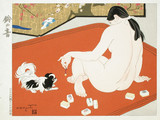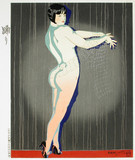Japan Wikipedia: Born April 5, 1873 in Kochi City, Kochi Prefecture as the eldest son of Ishikawa Yoshitada. He first learned Western-style painting from Uemura Masanori when he was in junior high school under the old system. He moved to Tokyo in 1891 and studied at Koyama Shotaro's private painting school called Fudosha. He also exhibited his work at the Paris World Exposition in 1900. In the following year, 1901, due to the organizational reform of the Meiji Bijutsukai, he became a new committee member and formed Taiheiyogakai with Yoshida Hiroshi and Mitsutani Kunishiro. He continued to make sculptures.
From 1902 to 1904, he studied in Europe and the United States and presented his works. In 1907, he won the third prize for "Still life" exhibited at the Tokyo Industrial Exposition. He also exhibited at the 1st Bunten Exhibition in the same year, and continued to exhibit many works at the Bunten, Teiten, Shinbunten, and Nitten exhibitions after the first, and later served as a committee member, auditor, and judge to guide the next generation. He also founded the Doyo Bijutsukai with artists from Kochi living in Tokyo. "Chrysanthemum", exhibited at the 2nd Bunten Exhibition in 1908, won third prize. In the 3rd Bunten held in 1909, "Grapes" received a commendation. From the end of the Meiji period to the Taisho period, he mainly painted portraits of women, such as nudes, and beautiful women.
Among Toraji's landscape paintings, there are many works that skillfully use colors to capture the landscapes of various parts of Japan. From 1900 to 1902, he exhibited his works in various places in Europe and the United States, showing a strong desire to create and be active not only in Japan. At the Bunten Exhibition in 1913, "Harbor in Afternoon" won second prize. He also exhibited at the Meiji Bijutsukai. His representative works include "Wild Duck" exhibited at the 5th Meiji Bijutsukai Exhibition in 1893, and the aforementioned "Harbor in Afternoon". At the 1915 San Francisco Exposition, "Still Life" won the third prize. From a young age, he made many sketching trips not only to various parts of Japan, but also to Taiwan, the Gangnam region of China, and the Korean Peninsula, and painted bright works in the impressionist style. In 1918, he worked on the mural paintings of the New Government Building of Taiwan's Governor-General's Office. In 1919, he became a temporary member of the Ministry of Education's teacher certification committee, a position he served for the next 15 years.
From 1918, he taught art at the Tokyo Higher Normal School, making achievements in terms of art education. Around 1934, he released woodblock prints using ukiyo-e techniques . In "Passage of Sudden Rain", people busily moving about at the port where junk boats gather after a sudden rain are depicted in soft colors that divide the color planes, clearly conveying Toraji's expressive intentions. Kazue Yamagishi is in charge of carving this work , and Keizaburo Matsuzaki is in charge of printing.
In 1937, he established the Marine Art Association with Ishii Hakutei and Mikuriya Junichi, and served as secretary with Kobayashi Mango. In 1938, he was dispatched to Shanghai, Nanjing, and Anqing in China as a part-time commissioner from the Ministry of the Navy, and was dispatched to the south during the Pacific War, where he drew battlefields and painted war records. In 1943, he went to China as a military painter. In 1941, he had reorganized the Kaikai Bijutsu Kai mentioned above into the Dai Nippon Kaiju Bijutsu Kyokai. Exhibitions related to war art include the 1st Maritime Art Exhibition held in 1937, the 2nd Maritime Art Exhibition held in 1938, the 5th Maritime Art Exhibition held in 1941, the sixth in 1942 and the 8th in 1944. Furthermore, the Ministry of the Army and the Ministry of the Navy held a Wartime Special Exhibition held in 1944 in which he participated. In 1943, he became the principal of the Taiheiyo Art School.
After the war, he became a judge at the Nitten (Nihon bijutsu tenrankai Japan Fine Arts Exhibition). In 1947, he left the Taiheiyogakai and founded Jigenkai where he assumed the position of representative. He also served as a lecturer at the Tokyo University of Education for five years from 1949, and devoted himself to further art education. In 1953 he received the Imperial Prize of the Japan Art Academy. In 1958 he became an auditor of the Nitten. On August 1, 1964, he died of heart failure while being treated for sepsis at Ito Hospital in Harajuku , Shibuya-ku , Tokyo.
Ishikawa Toraji
3 records
Include records without images
About this artist


